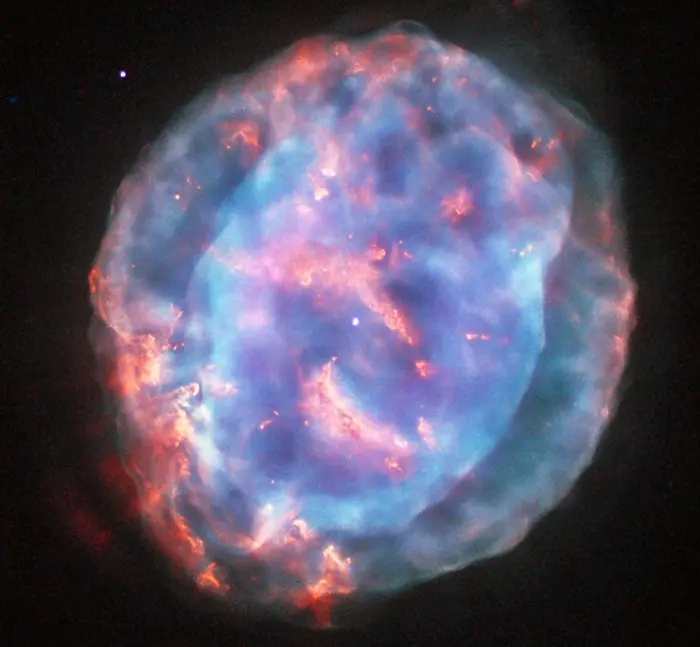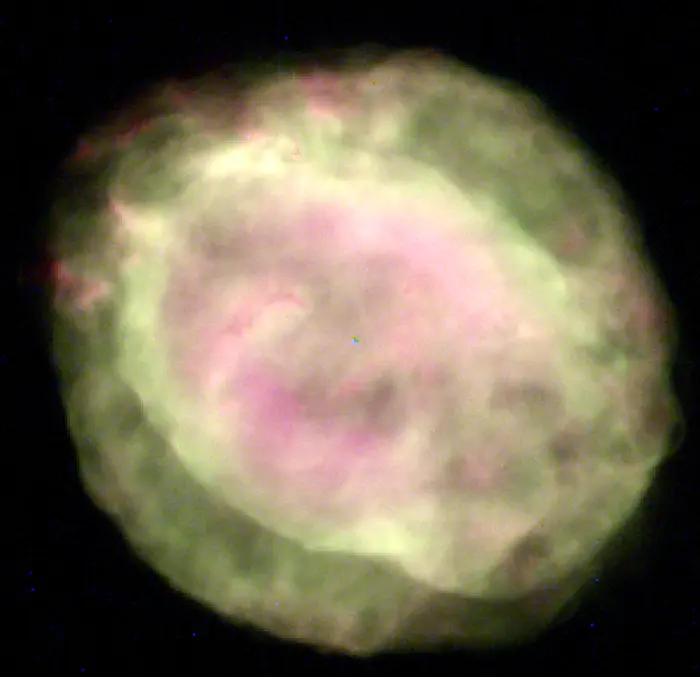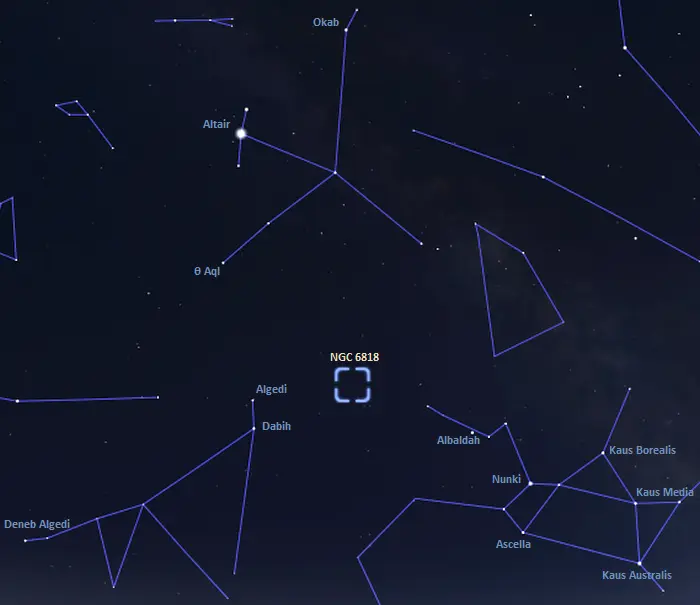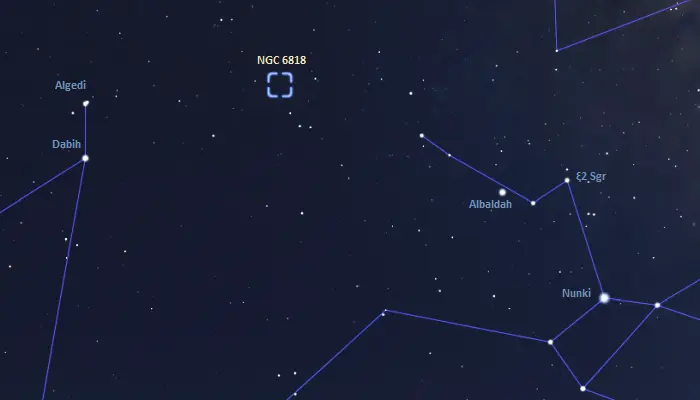The Little Gem Nebula is a planetary nebula located approximately 6,000 light years away in the constellation Sagittarius. It has an apparent magnitude of 10 and an apparent size of 0.44 by 0.44 arcminutes. It is listed as NGC 6818 in the New General Catalogue.
The nebula stretches about 0.64 light-years across in diameter. The nebula’s central star shines at 15th magnitude. It is catalogued as HD 186282 in the Henry Draper Catalogue.
The Little Gem was formed when a star similar to the Sun reached the late stages of its life and expelled its outer layers. The ejected gaseous envelope formed the complex shapes of the nebula that are illuminated by the exceptionally hot exposed core of the central star.

This colourful bubble is a planetary nebula called NGC 6818, also known as the Little Gem Nebula. It is located in the constellation of Sagittarius (The Archer), roughly 6000 light-years away from us. The rich glow of the cloud is just over half a light-year across — humongous compared to its tiny central star — but still a little gem on a cosmic scale. When stars like the Sun enter retirement, they shed their outer layers into space to create glowing clouds of gas called planetary nebulae. This ejection of mass is uneven, and planetary nebulae can have very complex shapes. NGC 6818 shows knotty filament-like structures and distinct layers of material, with a bright and enclosed central bubble surrounded by a larger, more diffuse cloud. Scientists believe that the stellar wind from the central star propels the outflowing material, sculpting the elongated shape of NGC 6818. As this fast wind smashes through the slower-moving cloud it creates particularly bright blowouts at the bubble’s outer layers. Hubble previously imaged this nebula back in 1997 with its Wide Field Planetary Camera 2, using a mix of filters that highlighted emission from ionised oxygen and hydrogen (opo9811h). This image, while from the same camera, uses different filters to reveal a different view of the nebula. A version of the image was submitted to the Hubble’s Hidden Treasures image processing competition by contestant Judy Schmidt. Image credit: ESA/Hubble & NASA; Acknowledgement: Judy Schmidt (geckzilla.com) (CC BY 4.0)
When they reach the asymptotic giant branch (AGB) phase of their life cycles, low to intermediate-mass stars start losing a large amount of mass. The mass loss is uneven and produces the multiple shells seen in planetary nebulae like NGC 6818. The central bubble of the Little Gem is enclosed in layers of material ejected in an earlier evolutionary phase of the central star.
The central star’s stellar wind drives the outflow of material, producing the elongated shape of the nebula. The bright regions in the outer layers are created by the stellar wind as it collides with the slower-moving gas clouds.
Facts
The Little Gem Nebula was discovered by the German-born British astronomer William Herschel on August 8, 1787.
NGC 6818 is sometimes also called the Green Mars Nebula. It shares the nickname (the Little Gem) with the planetary nebula NGC 6445, which is also located in Sagittarius. NGC 6445 appears slightly fainter but larger than NGC 6818. It is more commonly known as the Box Nebula. It appears near the bright open cluster Messier 23.

This Wide Field and Planetary Camera 2 image of NGC 6818 shows two distinct layers of gas (with dust): a spherical outer region and a brighter, vase-shaped interior ‘bubble.’ Astronomers believe that a fast wind – material propelled by radiation from the hot central star – is creating the inner elongated shape. The central star of the planetary nebula appears as a tiny blue dot. The material in the wind is traveling so fast that it smashes through older, slower-moving stellar debris, causing a ‘blowout’ at both ends of the bubble (lower right and upper left). Image credit: Robert Rubin (NASA/ESA Ames Research Center), Reginald Dufour and Matt Browning (Rice University), Patrick Harrington (University of Maryland), and NASA/ESA (PD)
Location
The Little Gem Nebula appears in the region of the sky between the Teapot in Sagittarius and the constellation figures of Aquila (the Eagle) and Capricornus (the Sea Goat). The nebula lies a little more than hallway from Ascella (Zeta Sagittarii) in the Teapot to Theta Aquilae in Aquila. A line extended from Kaus Media (Delta Sagittarii) through Albaldah (Pi Sagittarii) points in the direction of the Little Gem.
The nebula appears next to a curved line formed by three faint Sagittarius stars east of the Teapot. At declination -14° 09’, it is visible from most locations on Earth for at least part of the year.

The location of the Little Gem Nebula (NGC 6818), image: Stellarium

Little Gem Nebula location, image: Stellarium
The best time of the year to observe the Little Gem Nebula and other deep sky objects in Sagittarius is during the month of August, when the celestial Archer appears higher above the horizon in the early evening.
Little Gem Nebula (NGC 6818)
| Constellation | Sagittarius |
| Object type | Planetary nebula |
| Right ascension | 19h 43m 57.8s |
| Declination | −14° 9′ 11.9″ |
| Apparent magnitude | 10 |
| Apparent size | 0.44366670 x 0.44366670 arcminutes |
| Distance | 6,000 light-years (1,840 parsecs) |
| Radius | 0.32 light-years |
| Names and designations | Little Gem Nebula, NGC 6818, PK 25-17.1, PN G025.8-17.9, PN ARO 12, PN Sa 2-392, PN VV 241, PN VV’ 511, SCM 250, AT20G J194357-140911, HD 186282, BD-14 5523, GCRV 12096, GALEX J194357.7-140910, GALEX J194357.7-140912, GALEX J194357.7-140911, IRAS 19411-1416, 2MASX J19435802-1409134 |